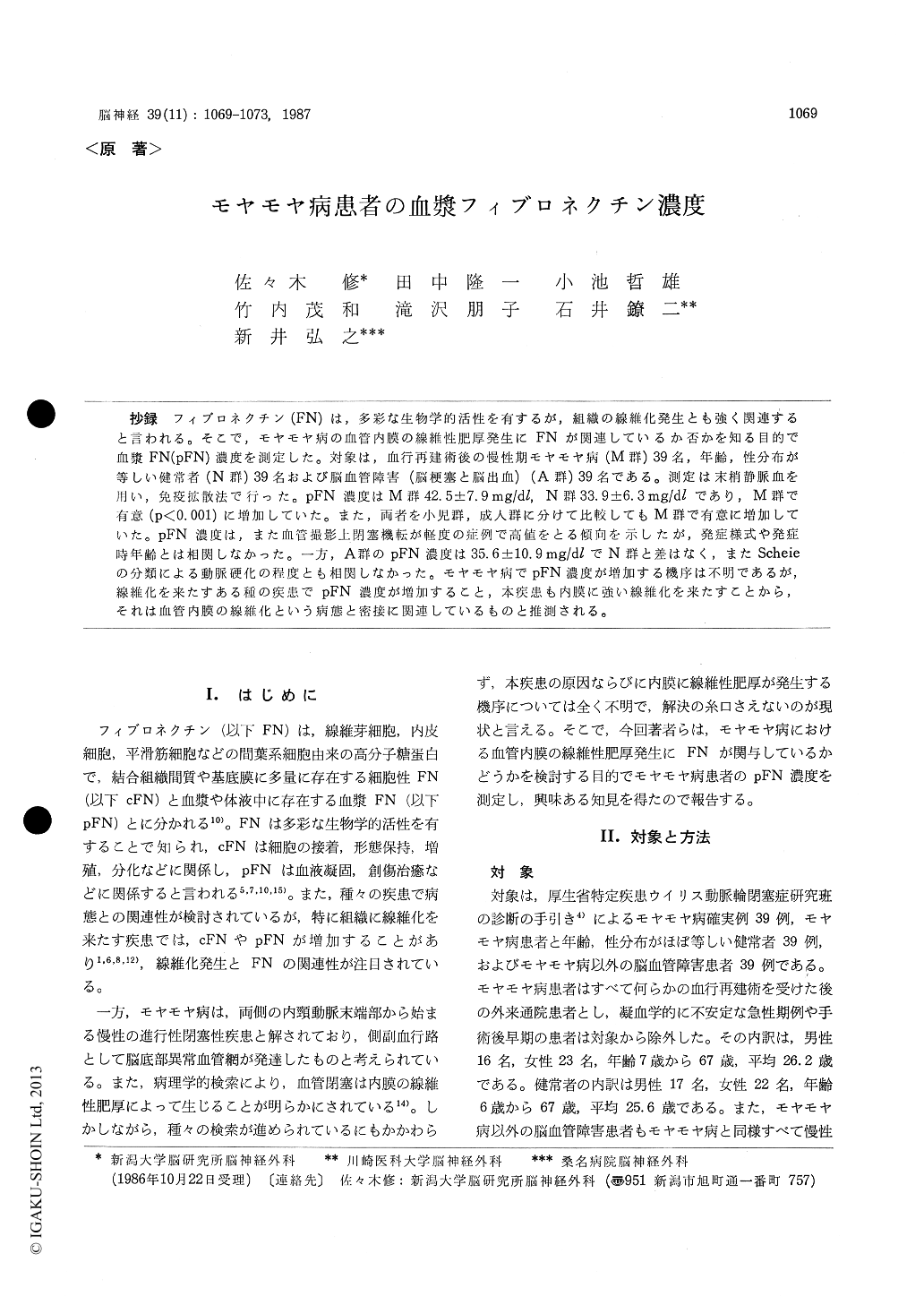Japanese
English
- 有料閲覧
- Abstract 文献概要
- 1ページ目 Look Inside
抄録 フィブロネクチン(FN)は,多彩な生物学的活性を有するが,組織の線維化発生とも強く関連すると言われる。そこで,モヤモヤ病の血管内膜の線維性肥厚発生にFNが関連しているか否かを知る目的で血漿FN (pFN)濃度を測定した。対象は,血行再建術後の慢性期モヤモヤ病(M群)39名,年齢,性分布が等しい健常者(N群)39名および脳血管障害(脳梗塞と脳出血)(A群)39名である。測定は末梢静脈血を用い,免疫拡散法で行った。pFN濃度はM群42.5±7.9mg/dl,N群33.9±6.3mg/dlであり,M群で有意(p<0.001)に増加していた。また,両者を小児群,成人群に分けて比較してもM群で有意に増加していた。pFN濃度は,また血管撮影上閉塞機転が軽度の症例で高値をとる傾向を示したが,発症様式や発症時年齢とは相関しなかった。一方,A群のpFN濃度は35.6±10.9mg/dlでN群と差はなく,またScheieの分類による動脈硬化の程度とも相関しなかった。モヤモヤ病でpFN濃度が増加する機序は不明であるが,線維化を来たすある種の疾患でpFN濃度が増加すること,本疾患も内膜に強い線維化を来たすことから,それは血管内膜の線維化という病態と密接に関連しているものと推測される。
Moyamoya disease is generally considered as a slowly progressive occlusive disease of the circle of Willis. Pathological investigation has revealed that the occlusion develops due to fibrocellular thickening of the intima. In spite of various stu-dies, however, the etiology of this disease and the mechanism of the intimal thickening remain unknown.
Fibronectin (FN) is a high molecular weight glycoprotein which is found in an insoluble form in many tissues and in a soluble form in plasmaand other body fluids. FNs have many biological activities and play an important role in the forma-tion of connective tissue under physiological and pathological conditions. In the present study we have determined the plasma FN levels in oder to investigate the relationship between FN and moyamoya disease.
The subjects were 39 patients with moyamoya disease who were in the chronic stage after recon-structive surgery, 39 age- and sex-matched normal healthy controls, and 39 patients with atheroscle-rotic cerebrovascular disease in the chronic stage. The plasm FN levels were measured by the single radial immunodiffusion method using venous blood samples.
The plasma FN level in healthy subjects was 33. 9±6. 3 mg/dl (mean±standard deviation) which almost agreed with the level, 30-35 mg/dl, reported by some investigators. In the patients with moya-moya disease the level was 42.5±7. 7. 9 mg/dl, show-ing a significant increase (p<0.001) compared with the healthy subjects. Then the subjects were classified into a child group (15 years or younger) and an adult group (16 years or older) and their levels were examined. The levels in the child healthy group, the child patient group, the adult healthy group, and the adult patient group were 34.0 ± 5.2 mg/dl (mean 11.2 years), 41.9 ± 7.3 mg/ dl (mean 12.3 years), 33.8±7.4 mg/dl (mean 37.9 years), and 43.1±8.6 mg/dl (mean 38.2 years), respectively. These figures indicated a significant increase (p<0. 001) in the patients with moyamoya disease, regardless of age. The age and the pattern of onset examined showed no relation to plasma FN levels, while angiograms showed that the level tended to increase in the patients in the early stage of this disease.
In patients with atherosclerotic cerebrovascular disease, the level was 35.6 ± 10.2 mg/dl, which was not differnt from that in the healthy subjects. There was no significant correlation between the FN level and the degree of atherosclerosis as evaluated by Scheie's classification of occular fundi.
The present study shows the plasma FN level increases significantly in the patients with moya-moya disease, especially in the early stage of the disease. The mechanism of the increase has not yet been clarified. However, in view of the find-ings reported in the literatures that the plasma FN levels increase in some disease that induce tissue fibrosis, we have assumed that an increase in plasma FN levels in moyamoya disease is closely associated with the development of fibrocellular thickening of the intima.

Copyright © 1987, Igaku-Shoin Ltd. All rights reserved.


